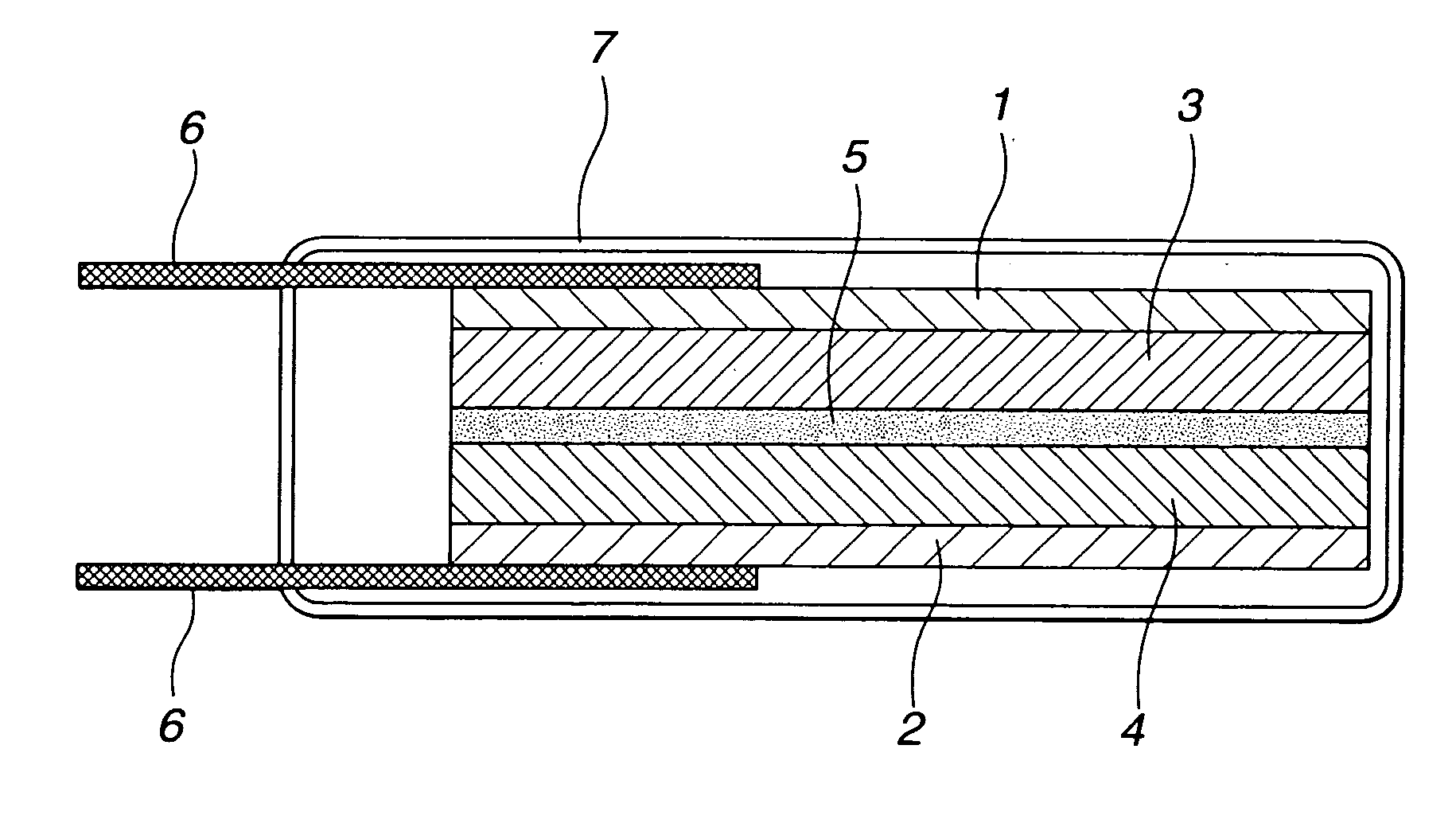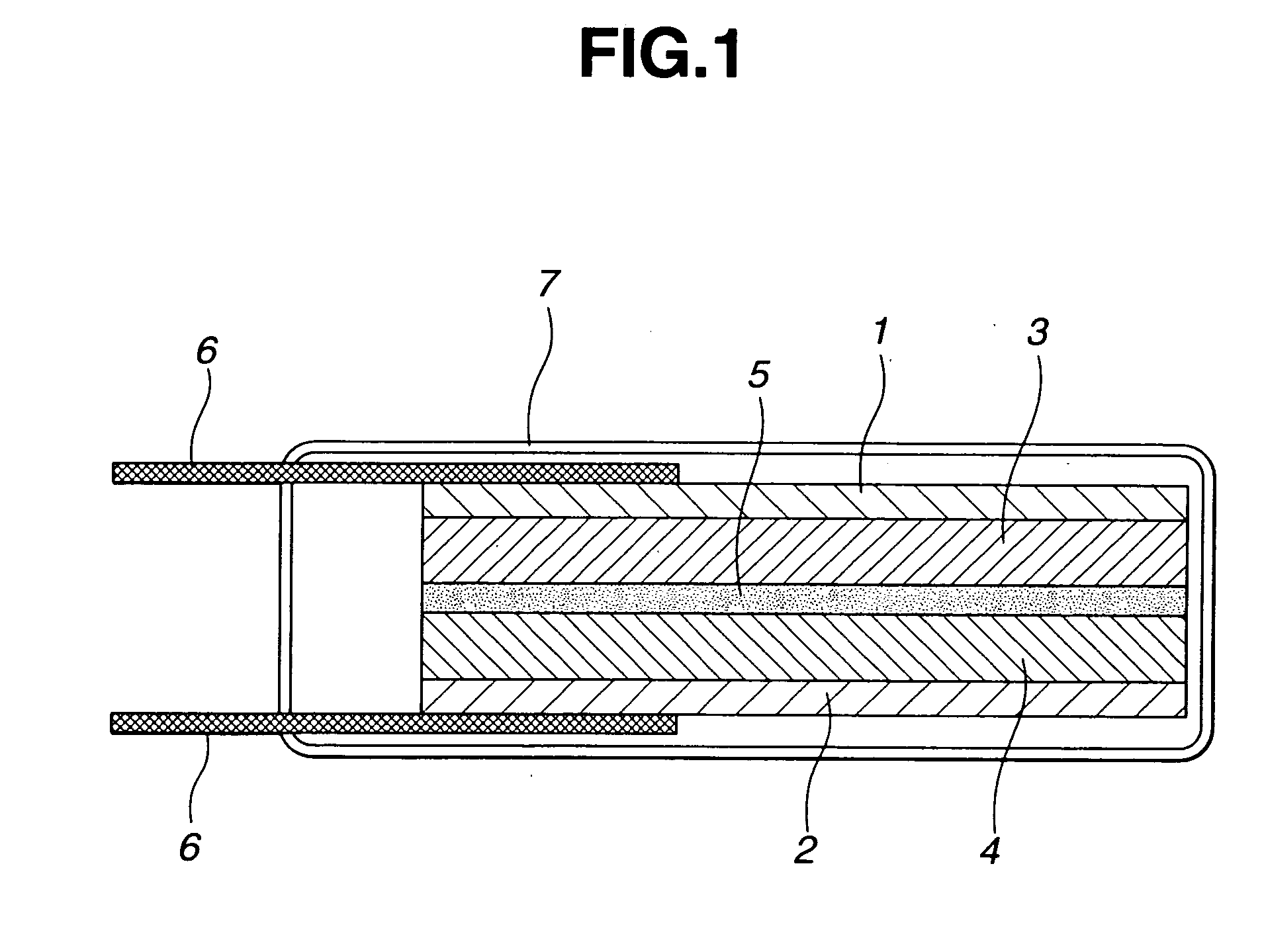Polymer gel electrolyte, secondary cell, and electrical double-layer capacitor
a polymer gel electrolyte and secondary cell technology, applied in the direction of non-metal conductors, cell components, electrochemical generators, etc., can solve the problems of compromising the long-term reliability of batteries or capacitors, low ionic conductivity, and difficult to achieve low-flash-point flammable non-aqueous electrolyte solutions, etc., to achieve excellent fire retardance, low vapor pressure, and high safety
- Summary
- Abstract
- Description
- Claims
- Application Information
AI Technical Summary
Benefits of technology
Problems solved by technology
Method used
Image
Examples
synthesis example 1
Synthesis of Unsaturated Polyurethane Compound
[0278] A reactor equipped with a stirrer, a thermometer and a condenser was charged with 870 parts by weight of dehydrated ethylene oxide (EO) / propylene oxide (PO) random copolymer diol (molar ratio of EO / PO=7 / 3) having a hydroxyl number of 36.1, 107.4 parts by weight of 4,4′-diphenylmethane diisocyanate, and 100 parts by weight of methyl ethyl ketone as the solvent. These ingredients were mixed by 3 hours of stirring at 80° C., giving a polyurethane prepolymer with isocyanate end groups.
[0279] Next, the entire reactor was cooled to 50° C., then 0.3 part by weight of benzoquinone, 5 parts by weight of dibutyltin laurate, 16.3 parts by weight of hydroxyethyl acrylate and 6.3 parts by weight of 1,4-butanediol were added, and the ingredients were reacted at 50° C. for 3 hours. The methyl ethyl ketone was subsequently removed under a vacuum, yielding an unsaturated polyurethane compound.
[0280] The weight-average molecular weight of the re...
synthesis example 2
Synthesis of Cellulose Derivative
[0281] Eight grams of hydroxypropyl cellulose (molar substitution, 4.65; product of Nippon Soda Co., Ltd.) was suspended in 400 mL of acrylonitrile, following which 1 mL of 4 wt % aqueous sodium hydroxide was added and the mixture was stirred 4 hours at 30° C.
[0282] The reaction mixture was then neutralized with acetic acid and poured into a large amount of methanol, giving cyanoethylated hydroxypropyl cellulose.
[0283] To remove the impurities, the cyanoethylated hydroxypropyl cellulose was dissolved in acetone, following which the solution was placed in a dialysis membrane tube and purified by dialysis using ion-exchanged water. The cyanoethylated hydroxypropyl cellulose which settled out during dialysis was collected and dried.
[0284] Elemental analysis of the resulting cyanoethylated hydroxypropyl cellulose indicated a nitrogen content of 7.3 wt %. Based on this value, the proportion of the hydroxyl groups on the hydroxypropyl cellulose that we...
synthesis example 3
Synthesis of Glycidol Derivative
[0285] A glycidol-containing flask was charged with methylene chloride as the solvent to a glycidol concentration of 4.2 mol / L, and the reaction temperature was set at −10° C.
[0286] Trifluoroborate diethyl etherate (BF3.OEt2) was added as the catalyst (reaction initiator) to a concentration of 1.2×10−2 mol / L, and the reaction was carried out by stirring for 3 hours under a stream of nitrogen. Following reaction completion, methanol was added to stop the reaction, after which the methanol and methylene chloride were removed by distillation in a vacuum.
[0287] The resulting crude polymer was dissolved in water and neutralized with sodium hydrogen carbonate, after which the solution was passed through a column packed with an ion-exchange resin (produced by Organo Corporation under the trade name Amberlite IRC-76). The eluate was passed through 5C filter paper, the resulting filtrate was distilled in vacuo, and the residue from distillation was dried.
[...
PUM
| Property | Measurement | Unit |
|---|---|---|
| vapor pressure | aaaaa | aaaaa |
| vapor pressure | aaaaa | aaaaa |
| service temperature | aaaaa | aaaaa |
Abstract
Description
Claims
Application Information
 Login to View More
Login to View More - R&D
- Intellectual Property
- Life Sciences
- Materials
- Tech Scout
- Unparalleled Data Quality
- Higher Quality Content
- 60% Fewer Hallucinations
Browse by: Latest US Patents, China's latest patents, Technical Efficacy Thesaurus, Application Domain, Technology Topic, Popular Technical Reports.
© 2025 PatSnap. All rights reserved.Legal|Privacy policy|Modern Slavery Act Transparency Statement|Sitemap|About US| Contact US: help@patsnap.com



